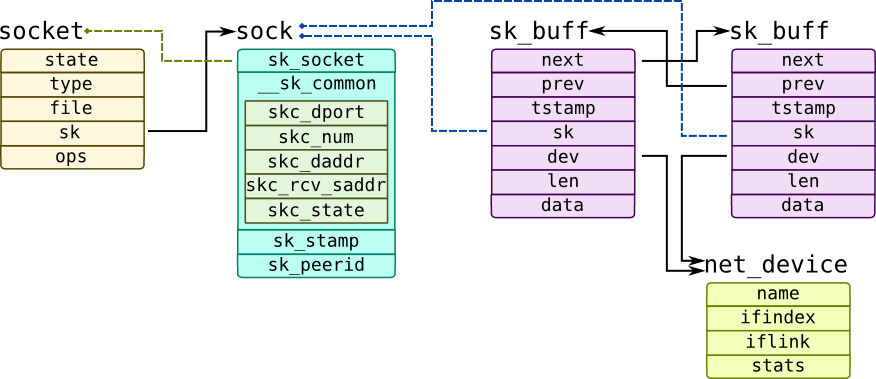Objects Relationship

socket object
userspace藉由system call API: sys_socket()產生,結構中有一個 sock object
struct socket {
socket_state state;
kmemcheck_bitfield_begin(type);
short type;
kmemcheck_bitfield_end(type);
unsigned long flags;
. . .
struct file *file;
struct sock *sk;
const struct proto_ops *ops;
};
(include/linux/net.h)
sock object
L3的抽象代表層(for scoket object),會擁有很多個sk_buff(也就是很多封包,用linked-list存)
struct sock {
struct sk_buff_head sk_receive_queue;
int sk_rcvbuf;
unsigned long sk_flags;
int sk_sndbuf;
struct sk_buff_head sk_write_queue;
. . .
unsigned int sk_shutdown : 2,
sk_no_check : 2,
sk_protocol : 8,
sk_type : 16;
. . .
void (*sk_data_ready)(struct sock *sk, int bytes);
void (*sk_write_space)(struct sock *sk);
};
sk_type: socket的類型,像是:SOCK_STREAM, SOCK_RAW等等。(include/linux/net.h) sk_write_queue: 這就是retransmission queue
sk_buff_head object
這就是sk_buff的linked-list
sk_buff(skb)
- 當封包抵達device,net device driver就會allocate skb
- 有net_device,查詢硬體資訊,比方說MTU等等
當packet只是forward用的時候,sk=NULL(sock object)。
struct sk_buff { . . . struct sock *sk; struct net_device *dev; // 下面有補充 . . . __u8 pkt_type:3, // L2決定:broadcast, muticast... . . . __be16 protocol; . . . sk_buff_data_t tail; sk_buff_data_t end; unsigned char *head, *data; sk_buff_data_t transport_header; sk_buff_data_t network_header; sk_buff_data_t mac_header; . . . }; (include/linux/skbuff.h)一個skb包含L2,L3,L4的 header & payload。
skb的操作方式:
- data: 正在處理的payload
- tail: end of payload
- len: tail - data
L2 -> L3
net_device
struct net_device {
unsigned int irq; /* device IRQ number */
. . .
const struct net_device_ops *netdev_ops;
. . .
unsigned int mtu;
. . .
unsigned int promiscuity;
. . .
unsigned char *dev_addr;
. . .
};
(include/linux/netdevice.h)